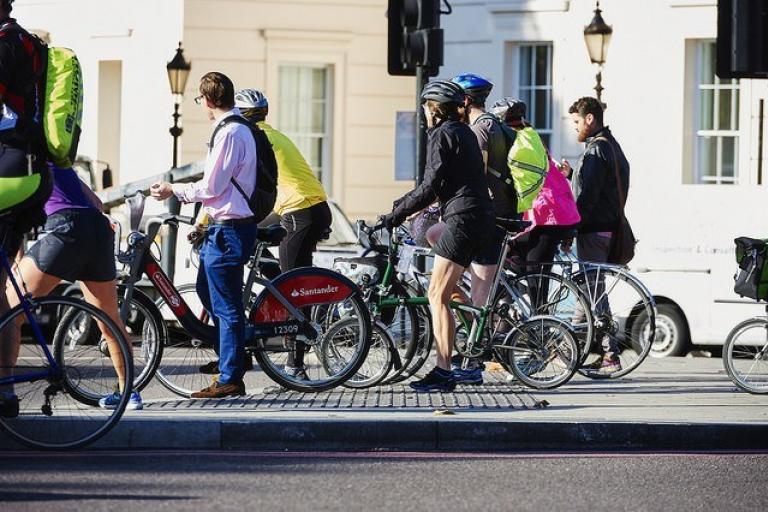- News
- Reviews
- Bikes
- Accessories
- Accessories - misc
- Computer mounts
- Bags
- Bar ends
- Bike bags & cases
- Bottle cages
- Bottles
- Cameras
- Car racks
- Child seats
- Computers
- Glasses
- GPS units
- Helmets
- Lights - front
- Lights - rear
- Lights - sets
- Locks
- Mirrors
- Mudguards
- Racks
- Pumps & CO2 inflators
- Puncture kits
- Reflectives
- Smart watches
- Stands and racks
- Trailers
- Clothing
- Components
- Bar tape & grips
- Bottom brackets
- Brake & gear cables
- Brake & STI levers
- Brake pads & spares
- Brakes
- Cassettes & freewheels
- Chains
- Chainsets & chainrings
- Derailleurs - front
- Derailleurs - rear
- Forks
- Gear levers & shifters
- Groupsets
- Handlebars & extensions
- Headsets
- Hubs
- Inner tubes
- Pedals
- Quick releases & skewers
- Saddles
- Seatposts
- Stems
- Wheels
- Tyres
- Health, fitness and nutrition
- Tools and workshop
- Miscellaneous
- Tubeless valves
- Buyers Guides
- Features
- Forum
- Recommends
- Podcast
news
Marginal flaps? Ganna’s baggy skinsuit and stacked team car under scrutiny; I’m Gonna Bee (500 Miles): Andy Burnham says miserly active travel figures “wrong”; Lack of bike storage hinders commute; ITV on Highway Code changes + more on the live blog
SUMMARY
No Live Blog item found.
 Ganna Dauphine 2022 (via GCN)
Ganna Dauphine 2022 (via GCN)09 June 2022, 16:59
I’m Gonna Bee (500 Miles)
Before I sign off for tonight, I have to thank reader AlsoSomniloquism for pointing out that under Andy Burnham’s revised estimate for Greater Manchester’s Bee Network, “you could walk (cycle) 500 miles but will have to wait several more years to walk (cycle) 500 more”.
If I have to have “Da-da da da (da-da da da)” in my head all evening, so do you…
09 June 2022, 16:23

Bikes, bikes, bikes! Stranded stag do party buy bikes to make it home after flight cancelled
This Saturday will mark my third stag do of 2022 (one of which was my own), so it’s safe to say that I’m pretty much over them by now.
And just for the record, the most exotic of those outings was to Bristol (and two of them were twenty minutes from my house) – none of this Magaluf nonsense…
Anyway, a group of lads, lads, lads made the Mirror today after their flight home from a stag weekend in Amsterdam was cancelled.
After deciding to board the ferry from Calais, they were then told that due to health and safety rules, foot passengers weren’t permitted on the day’s final boat, but those with bikes were allowed.
Cue montage, as the fourteen fellas scurried about Belgium and northern France in what must have resembled a low-budget, less angry version of Top Gear, buying bikes ranging from £40 iron gates to lofty £200 machines online and from local second-hand shops.
Unfortunately, the lads didn’t organise a post-stag Lille-Calais 100km sportive, and instead got taxis (at £300 a pop) to the port. Spoil sports.
So if we’ve learnt anything from this experience (I’m sure someone has, somewhere), it’s that stag weekends are horrible, and bikes are great.
Now a proper cycling stag do, that's another matter entirely...
09 June 2022, 15:44
09 June 2022, 15:37
The only kind of sportswashing I’ll stand for…
Sports washing? Moi! pic.twitter.com/hUhOm0ZC0S
— Paul Kimmage (@PaulKimmage) June 9, 2022
09 June 2022, 15:25
09 June 2022, 14:59
Critérium du Dauphiné: Van Aert learns his lesson to take second stage win
𝓤𝓷𝓫𝓮𝓵𝓲𝓮𝓿𝓪𝓫𝓵𝓮 finish to Stage 5!
Wout van Aert snatches victory on the line, just ahead of Jordi Meeus, in a warp speed bunch sprint #Dauphiné pic.twitter.com/FG9jjF7R4X
— Eurosport (@eurosport) June 9, 2022
They say every second counts, but I’m sure Wout van Aert was relieved to avoid yet another runners-up spot at the Critérium du Dauphiné today, taking his second win of the week after two near misses in a row.
The Belgian champion even learned his lesson following Tuesday’s surprise defeat to David Gaudu, and threw his bike at the line to fend off a strong sprint from Jordi Meeus in Chaintré.
While the ghosts of stage three were firmly exorcised, Van Aert must also have worried that he was reliving Monday’s ride to Brives-Charensac, as a spirited four-man breakaway was only swallowed up by the Jumbo-Visma lead out train in the final 250 metres.
Ineos’ Ethan Hayter, living up to his consistent mini-WVA reputation, was yet again there or thereabouts, finishing third.
While Van Aert successfully tore up the looming ‘nearly man’ script, Dylan Groenewegen must be concerned that he is getting typecast – the BikeExchange rider was again shelled out the back after pressure from Jumbo-Visma and Ineos (Filippo Ganna’s jersey flapping in the wind) on the small climbs that characterised the finale, and failed to contest the sprint.
With tougher days to come, the Dutch sprinter’s time in the spotlight has come to an end. Van Aert, meanwhile, will surely aim to maintain his starring role.
09 June 2022, 14:34

Women’s Tour: Grace Brown takes stage and leader’s jersey after frenetic finale in Welshpool
The GC battle began in earnest on stage four of the Women’s Tour into Welshpool, as FDJ Nouvelle-Aquitaine Futuroscope’s Grace Brown took her first win of the season, beating Kasia Niewiadoma and Elisa Longo Borghini in a three-up sprint after an exhilarating finale.
The trio, who had been part of a ten-rider move which forged clear of the bunch on the lumpy Welsh terrain, contested the stage after Brown had attacked with around four kilometres to go, with Longo Borghini and Niewiadoma putting in a serious shift to catch the flying Aussie.
The Italian champion Longo Borghini, lacking the acceleration of her rivals, was unsurprisingly the first to launch the sprint, with a confident Brown patiently biding her time before surging by for a convincing victory.
Grace Brown (@FDJ_NAqui_Fut) wins stage four of the Women’s Tour in Welshpool 🏆#WomensTour #UCIWWT pic.twitter.com/ZIGAAxuTVo
— The Women's Tour (@thewomenstour) June 9, 2022
With tomorrow’s queen stage, and a summit finish on Black Mountain, awaiting the Women’s Tour peloton, new race leader Brown will be hoping she can maintain her sparkling form on the race’s highest slopes.
Lead image: Simon Wilkinson/SWpix.com
09 June 2022, 14:15
Yet more pre-Tour tech updates...
09 June 2022, 13:50

Flapsgate update: Bioracer staff member says new fabric “is significantly faster but not as elastic”
With Top Ganna’s baggy elbows sparking some debate this morning, a staff member from Bioracer – Ineos Grenadiers’ kit supplier – got in touch with road.cc to clear a few things up.
The staffer, who says he drove the time trial world champion’s skinsuit to the Ineos team hotel overnight from Belgium before the stage, told us:
“The suit was long sleeve, standard model (as in the “standard model” we make for him and all the team – albeit his exact pattern fit), with welded seams (as is now standard on our Speedmaster versions).
“The baggy elbows are due to the sleeves and forearms fabrics being not quite as elastic as the “old” lycra previously used here.
“The new fabrics need to be cut and welded to perfectly fit when in the tuck position, slightly baggy when not obviously.
“The new fabric is significantly faster when used correctly, but not as elastic.”
Well, that clears that up (hopefully).
Now, on to the whole team car situation…
09 June 2022, 13:40
You learn something new every day, even when you’re Ned Boulting…
I have only just discovered that "critérium" (if French) is the name given to events in certain sports which are not, in themselves, championships. I didn't know that. I now do.
— Ned Boulting (@nedboulting) June 9, 2022
So one can’t be a Crit Champion!?! 😆
— BILLY ANDERSON (@BillyMikeKY) June 9, 2022
09 June 2022, 13:01
Bee Network blunder: New Greater Manchester strategy document says 60 miles of active travel routes to be built by 2024 – over 1,700 miles short of previous target… but Andy Burnham claims figure is wrong
Greater Manchester’s Bee Network of cycling and walking routes – once heralded as a “potential national blueprint” for active travel in the UK – has taken a bit of a hit in recent times… Well, that’s if you believe the region’s new strategy document for 2030 (which, according to GM mayor Andy Burnham, you shouldn’t).
Just over two years ago, in January 2020 (ah, those halcyon days), Burnham and the area’s then-cycling and walking commissioner Chris Boardman published a report entitled ‘Change a Region to Change a Nation’, highlighting the Bee Network’s ability to act as a model for others to follow to help tackle the climate emergency, reduce congestion and benefit public health.
According to the report, 1,800 miles of protected space for cyclists and walkers would be implemented over the following decade, resulting in a projected 350 per cent increase in daily cycling trips, from 100,000 to 450,000. Daily walking trips were also expected to rise by a third under the scheme, from 1,480,000 a day to 2,050,000.
But since that report, Boardman has left to take on the role of interim commissioner of Active Travel England, a new body tasked with implementing the government’s Gear Change strategy.
And a new strategy document, released today, appears to show a drastic scaling back of the Bee Network’s ambitions.
According to the Greater Manchester 2030 brochure, 100 kilometres of walking and cycling routes are set to be installed by 2024, a long way short of the original target of 1,800 miles by 2029:
Interesting nugget in the Greater Mamchester 2030 strategy about the Bee Network. Original @chris_boardman vision was for 1,800 miles of safe cycling and walking routes by 2029. Now they are aiming to build just 100km of it by 2024. pic.twitter.com/pC0hg8nCD3
— Helen Pidd (@helenpidd) June 9, 2022
Trying to do the maths quickly, is that a thirtieth of the original goal? In what proportion of the time (I'm thinking CB out his goal forward in 2019?), half of the time?
— Dave (@PequodDave) June 9, 2022
Dire.
— Owler Nook (@Owler_Nook) June 9, 2022
However, as any live blogger knows all too well, typos happen (especially in major regional strategy documents), and Andy Burnham’s press team soon got in touch with Guardian journalist Helen Pidd to clarify that the 100km claim was a simple mistake.
Instead, Burnham says that “the target is to deliver 500 miles of cycling/walking routes by 2024” and that the completion of the entire 1,800 Bee Network by 2029 is still very much on the cards.
A lot less dire.
— Owler Nook (@Owler_Nook) June 9, 2022
You just can’t find a descent editor these days…
09 June 2022, 11:52
09 June 2022, 11:51
Breaking pro cycling news: Adam Blythe wears socks!
Finally, one of the sport’s great unsolved mysteries has finally been put to rest, by the style icon himself…
People worrying about my socks… why does it bother you that you can see ankle…? Because I do wear socks!!?? pic.twitter.com/6B1D5sRyKU
— Adam Blythe (@AdamBlythe89) June 8, 2022
Some marginal socks there, eh Adam? Marginal socks, geddit? Ah, I give up...
09 June 2022, 10:55

Two million cyclists put off riding to work by lack of storage
According to new research from Direct Line Cycling Insurance, over two million cyclists have said they are discouraged from cycling to work due to a lack of adequate storage facilities.
Yesterday on the blog we reported that Cycling UK was taking advantage of Bike Week to tell employers to do more to persuade their staff to ride into work, such as providing financial incentives along with adequate storage and changing facilities.
Cycling UK’s stance has been backed up by a new study which suggests that three-quarters of cyclists are put off riding to work due to a range of factors, including: a lack of suitable bike storage, shower or changing facilities, the distance, difficulty and danger of the route to work, and variable weather conditions.
2.1 million cyclists said that a lack of storage space in their office was a barrier to their commute, while eight percent of those surveyed revealed that they used to have storage, but it has since been removed due to reduced office space.
Direct Line’s research also claims that 56 percent of all cyclists in the UK use their bike to commute to work, with a fifth cycling to work every day.
Those who commute frequently are also more likely to spend big on their bikes, with those cycling to work splashing out on average £873 on their machines (compared to an average spend for all cyclists of £554).
09 June 2022, 09:52
Popcorn at the ready: ITV “investigates the biggest changes to the Highway Code”
Set your VHS for 8.30pm this evening, as ITV’s Tonight show takes on the recent changes to the Highway Code (there were changes? Why did nobody tell me?).
Popcorn at the ready for ITVs Tonight programme “Who Rules Britains Roads?” tomorrow at 20:30 “investigates the biggest changes to the Highway Code”
They are using some of the close passes from my video compilation https://t.co/xiozQFggmS— Bikery (@Bikery1966) June 8, 2022
Can’t say the programme’s needlessly provocative title fills me with much hope, mind you – presenting Britain’s roads as a place of conquest, rather than a shared space for all road users, isn’t the most sensible strategy from the outset, I’m sure you’d agree.
But surely it can’t be worse than Countryfile’s recent segment on cycling safety, described on social media as “vile”, “disgraceful” and an “utter shitshow triggering anti-cycling hatred”.
The bar’s pretty low, to be fair…
But if you do find yourself screaming at the telly at half eight tonight, you can always flick over to ITV4 for highlights from the Women’s Tour. Much better.
09 June 2022, 09:24
Speaking of not so marginal gains...
I wonder how far this old trick pushes up against that fabled “thin blue line”?
This really needs to stop, on top of fact that car is likely too close to him anyway. Given calculations i've seen likely it gave him the win over Wout#Dauphine2022 pic.twitter.com/PRuyqTgY9G
— G Hofman (@letstalkcycling) June 9, 2022
What do you think about this latest piece of TT skulduggery, one also employed – though to a lesser extent – by Jumbo-Visma yesterday (but not, interestingly, for Ganna’s Ineos teammate Ethan Hayter)?
Does stacking the car roof with a frankly unnecessary wall-like amount of spare bikes (which, studies have shown, if driven close enough to the rider can push them along) give certain teams an unfair advantage which should be banned?
Or is all fair in love and time trialling, and are teams adopting this tactic simply and successfully pushing the boundaries of the existing rules?
09 June 2022, 08:49
Marginal flaps? Ganna’s loose-fitting skinsuit under scrutiny
As Filippo Ganna powered to victory at the Critérium du Dauphiné yesterday, the more nerdy corners of Cycling Twitter began speculating about a possible new breakthrough for the Ineos Grenadiers and their aero guru Dan Bigham.
That ground-breaking new discovery? Eh… baggy elbows, apparently.
With more than one Ineos rider having these flaps around the elbow, Ineos history and Bigham as staff this is no accident.
Didn’t see similar in the Jumbo suits. Another aero breakthrough by Bigham? https://t.co/CaGkChI99E
— Lena Kolumna (@reathina) June 8, 2022
My guess is that they are cut to be tight with elbows bent on the aero bars. The downside is that it’s looser with straight arms on the base bars. But I’m no aerodynamicist/tailor.
— Josh Warburg (@jcwarburg) June 8, 2022
They were definitely experimenting with suits then. Ganna had a different one from Hayter and arms could probably be tighter but today was a completely different level. If that wasn’t planned it was complete sabotage aerowise
— Lena Kolumna (@reathina) June 8, 2022
If by some weird twist of fate it turns out that saggy elbow flaps are actually aero, I would laugh so hard 😂
— Katy M (@writebikerepeat) June 8, 2022
Some, however, have claimed that Ganna (like any mediocre club ten rider) was merely wearing arm warmers underneath his time trial suit.
According to one Twitter user, who posted a photo of Ganna warming down in short sleeves, the arm warmers probably slipped during his stage-winning effort, causing him to resemble a trackie-wearing teenager from the 1990s (that’s Tour-winning attention to detail right there).
@anewcd found the probably answer. Ganna didn’t wear a long sleeved suit. The “arm warmers” probably slipped up a bit after 30km riding and created that unintentional flap. Also explains the double wc bands https://t.co/EQi78y6FUr
— Lena Kolumna (@reathina) June 8, 2022
That claim has been countered by other tech geeks, who maintain that the world champion's suit is indeed "optimised for bent arms":
Definitely not wearing the same suit in that picture, as he wore on the ride! His TT suit is one piece with long sleeves. I think it's optimised for bent arms!
— Neil McGurk (@mcgurk_neil) June 9, 2022
To be fair, if loose-fitting cycling clothing and shoddy arm warmers really were the key to success, I’d have cleaned up back in the day…
While ‘90s Kevin and Perry chic was enough to propel Ganna to victory by two seconds over the more streamlined Wout van Aert, Ineos teammate Ethan Hayter adopted an even more novel approach to time trialling, on his way to third place:
Sorry but as a contact lens wearer, for Ethan Hayter to put in THAT performance despite losing his visor is some king shit. A light breeze is enough to discombobulate me when I'm wearing mine 😅 #Dauphine #Dauphiné2022
— Katy M (@writebikerepeat) June 8, 2022
Is marginal sight the new marginal gain?
After obtaining a PhD, lecturing, and hosting a history podcast at Queen’s University Belfast, Ryan joined road.cc in December 2021 and since then has kept the site’s readers and listeners informed and enthralled (well at least occasionally) on news, the live blog, and the road.cc Podcast. After boarding a wrong bus at the world championships and ruining a good pair of jeans at the cyclocross, he now serves as road.cc’s senior news writer. Before his foray into cycling journalism, he wallowed in the equally pitiless world of academia, where he wrote a book about Victorian politics and droned on about cycling and bikes to classes of bored students (while taking every chance he could get to talk about cycling in print or on the radio). He can be found riding his bike very slowly around the narrow, scenic country lanes of Co. Down.
Add new comment
68 comments



Well, it's certainly worth getting worked up about, by golly.
?? I was just stating the facts. You seem to think it's worth getting personal over despite being very obviously wrong.
I'm not being personal at all, I just find it odd that you seem to have got in such a tizzy about some idle speculation about someone's shirt.

I'm not being personal at all, I just find it odd that you seem to have got in such a tizzy about some idle speculation about someone's shirt.
That's the very definition of personal. I'm not at all in a tizzy and there's no reason you would honestly think I am. Rather, you seem to be embarrassed about being wrong and have tried to deflect attention from that by making personal comments instead.



When you can't legally cycle through the pedestrianised city centre, but the Duke of Westminster who basically owns all the land Chester is built on, can drive his Bentley (other over the top cars could be used) whenever he wants, through the same pedestrianised area, you know you're fighting a losing battle.
Used to work there a decade ago. The cycling officer for the council couldn't even ride a bicycle!
Pages
- « first
- ‹ previous
- 1
- 2
- 3
Latest Comments
- TheBillder 4 sec ago
My new double glazed wooden framed sash windows are £1600 plus vat per (quite large) window. House built in 1904. The cost includes fitting and...
- galibiervelo 15 min 44 sec ago
We promote #bikefriday You dont need it - go for a spin. Nice bikes and kit are lovely, but not as noice as a dawn spin this friday morning with a...
- David9694 18 min 56 sec ago
Council acting like ‘the Sheriff of Nottingham’ with parking charges...
- David9694 23 min 4 sec ago
Man taken to hospital after vehicle crashes into pub...
- David9694 32 min 50 sec ago
Car flips in Millennium Way, Sheerness, near former Aldi supermarket that reopens as Home Bargains this weekend...
- RoubaixCube 1 hour 2 min ago
Ive been using the same £2-3 dish brush I bought from wilko, tesco or pound land for as long as I can remember. I dont understand why anyone would...
- S.E. 2 hours 37 min ago
I'm thinking CX tyres...
- kingleo 2 hours 48 min ago
Crossing the road is the big danger for pedestrians, not the cycle path.
- Hirsute 4 hours 7 min ago
More of an oblique reference to a cyclist being taken out when in the cycle lane in the same scenario. Of course the cyclist pretty much gets the...



